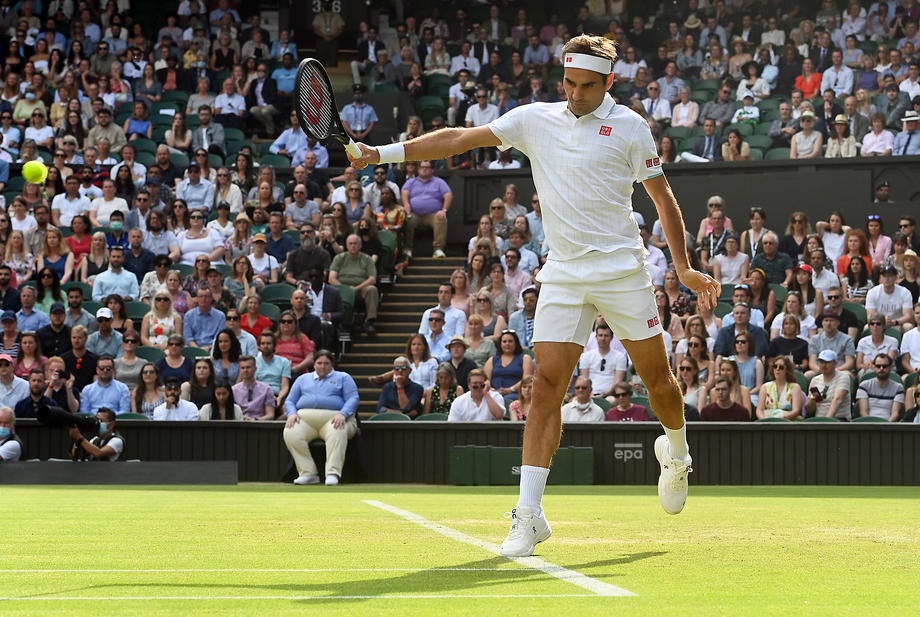- Stars Join Forces for Eisenhower Cup Return to Indian Wells on March 4
- Ken Thomas Broadcasting from Georgia’s Rome Tennis Open
- Solinco Launches All-New Whiteout V2 Racquet
- Stringlet: Serving Up Tennis Inspiration With A Twist
- Davis Cup qualifying to feature Brazil vs. France and Spain vs. Switzerland
- 2025 US Open Expands to Sunday Start
- Tennis Channel To Broadcast U.S. Davis Cup Qualifier vs. Tawain
- Stefanos Tsitsipas Receives Rotterdam Wild Card From Richard Krajicek
- Tien and Basavareddy to Play Delray Beach Open Qualifying
- Australian Open Tennis 2025 Ends with Madison Keys and Jannick Sinner As Winners By Alix Ramsay
- 2025 Australian Open Final Draws
- Jannik Sinner Sweeps Alexander Zverev for Second Straight Australian Open Title
- Ricky’s pick for the Australian Open final: Sinner vs. Zverev
- Australian Open Draws and Order Of Play for Sunday, January 26, 2025
- Madison Keys Upsets Defending Champion Aryna Sabalenka in Australian Open Final Thriller
2020 Tennis • Changing Of The Guard
- Updated: January 17, 2020
By Alix Ramsay
A new year is almost upon us and the big beasts of tennis are all either in Australia or on their way there. Before them stretches another 11 months of blood, sweat and tears as they try to establish who is the biggest, strongest and most successful among them.
As ever, everyone is looking to the younger generation to try to predict who will be the one to upset the establishment and position themselves at the top of the pecking order. The signs from 2019 are promising: Stefanos Tsitsipas won the ATP Tour Finals, Daniil Medvedev reached the US Open final and Dominic Thiem (a veteran youngster if ever there was one) reached his second French Open final. But, then again, Thiem lost to Rafa Nadal (again) as did Medvedev in New York and as for the London title, it has hardly proved to be the launchpad for the new boys (think Sascha Zverev in 2018 and Grigor Dimitrov in 2017).
As the 2019 season drew to a close, Nadal and Djokovic had two slams apiece and had chased each other all the way down to the wire for the end of the year No.1 ranking (Nadal won that particular foot race). Nadal then led Spain to Davis Cup triumph. Meanwhile, the young lads headed off on their holidays, clutching their runner-up trophies and pay cheques, wondering what they had to do next to try and elbow the old boys out of the way.
So what has caused this hiatus in time? Why has the clock stopped ticking on the careers of Nadal and Djokovic? And let us not forget the Mighty Federer who had two championship points in the Wimbledon final against Djokovic and still lost but then got his revenge by demolishing the Serb at the O2 Arena nearly four months later. That defeat ended Djoko’s hopes of ending the year as top dog and left a clear marker that Fed may be heading towards his 39th birthday but he has no intention of going away any time soon.

According to Sven Groeneveld, the wise head who has guided the careers of so many of the game’s greats, most recently Maria Sharapova and Sloane Stephens and who is now working with XXX, it all comes down to three basic factors: more tournaments, a new age of social media, business marketing and money and, most importantly of all, experience. And all three are intertwined.
Groeneveld was speaking just at Medvedev was making his way to the US Open final and while the Russian showed that he has all the necessary weapons to be a serial champion, he could not get past Nadal in New York. By the end of the season, he had run out of physical and mental puff – a fact that adds more weight to Groeneveld’s argument.
When the likes of Agassi, Sampras, Ivanisevic and Rafter – to name but a few – were coming to the end of their playing days, there were fewer tournaments to play in each week. As a result, those events were stuffed tight with big names and rising stars, all of whom had to be beaten in order to lift the trophy. These days, the pool of talent is spread more thinly across a much greater number of events. The result is the older stars have fewer major obstacles standing between them and the final Sunday.
“Where in the past, if there was one tournament for a top 50 player, now you have three tournaments for a top 50 player,” Groeneveld explained. “That means the top seed for each event will not find another competitor in the top 20 until the semi-final or quarter-final. So because of that, they can extend their career.
“If I look back at Becker, Edberg, Stich, Ivanisevic, Rafter, Agassi… these guys were playing all at the same time. We didn’t talk about the top three, we always talked about the top 10. Ten. Ten guys that were battling it out.
“Obviously the Rogers and Rafas, Novak and Andy, Stan – they equal that level of play, don’t get me wrong. But the older guys left the game back then because all of a sudden, when they dropped out of the top 16 as a top player, they could face a top seed [in the first round] and they left the game because they didn’t like the fact that they were starting to lose early.”
That all sounds simple enough but it does not explain why generations of new talent have failed to lay a glove on the Big Four (now the Big Three following Andy Murray’s hip problems) at the top of the game. But according to Groeneveld, that is where the modern age, complete with all its pressures, plus that healthy dose of experience, comes into play.
“The other element is the prize money increase,” Groeneveld said. “Every single human being has something to work towards, a goal. Some of them play to get a certain financial reward or get some sort of a recognition. And that’s the element of being significant within your own space.
“These goals can be separately translated by all these younger generations – but if they’ve reached a goal, it’s almost like they’ve achieved something that they never maybe expected would come so quick.
“So when you reach a goal, you’d better make sure that you have another goal. And that goal needs to be as important as that first goal that you’ve reached. But due to the fact that they’ve reached that first goal so much faster than expected, it almost gives them an almost empty feeling. And that’s what Tsitsipas said [after reaching the Australian Open semi-finals].
“He’s a young guy, how can he be empty? Well, he may have gotten a contract, he may have gotten the recognition he wanted, he may have gotten into the top five that he thought was impossible to reach. All these dreams and goals were achieved in such a small time frame and now, all of a sudden, it’s about ‘now when are you going to win a slam?’ All of a sudden it’s pressure, it’s no longer an element of ‘oh, this is what I would love to reach’. Now it’s become pressure: ‘when are you going to?’
“And obviously social media doesn’t have a very good influence on that. Because you do get a totally different interaction than if you were just on TV and in a newspaper or magazine and then it’s put to the side. You become so much more relevant all of a sudden because of the social media, their followers and so on.”
But it is the experience that the big boys have gathered over the years that sets them apart. Not only have they learned their own lessons on the court but they have surrounded themselves with people who know what it takes for their charge to win and then come back and win again. The refusal never to be satisfied, the need to improve, the desire to work until there is no fuel left in the tank – that is what makes the greats great.
“It’s a need that human beings have: the need of significance,” Groeneveld said. “And of course, there is a passion also for what you do. But if that need of significance is already satisfied earlier due to the external influences, if you don’t have that drive and that need… These guys, this was there from the beginning.”
Whether it was Djokovic turning up for his first lesson and stating that he wanted to be the world No.1 – and meaning it – or Federer’s desire to leave his mark on the history of the sport or Nadal’s need to compete, they were not born this way; they were shaped by everything around them.

Djokovic grew up in war-torn Yugoslavia, practicing with bombs dropping around him; Federer grew up in peaceful Switzerland but with parents who would not let him get above himself (when he got his first Nike contract as a teenager, his parents never told him there was money involved; he was simply told that the nice people at Nike wanted him to wear their clothes so he had better make sure he behaved and played well). And then there was Uncle Toni who taught Rafa that in order to succeed, he must first suffer. Embrace the suffering, the pain of hard work and more, and success will be possible. That is what makes the Big Three consistently great and as hard as nails – they chew nails and spit rust.
“They know,” Groeneveld said. “They know that there’s no shortcuts. That’s the thing that you focus on, you do everything to get into that state and hold on to that.”
Despite evidence to the contrary, the clock in tennis continues to tick. One day the old boys will have to stop and then the young lads will have their moment. Of those on show at the moment, Groeneveld can see some signs in a couple of them already – they may be ready to make a push forward.
“I see it in Felix [Augur-Aliassime]; Felix has a DNA that is a little bit similar to Rafa.” he said. “I hope he holds on to that. That’s very special. I think, deep down, Sascha has it as well. I do think they have it but it’s not on the surface.
“They all have it but they don’t know the leverage it takes to commit to that type of lifestyle and that type of commitment that is needed. And that is experience and that is where they are failing.
“There is the element of leverage, that they need to internalise and get to the backbone. They have it. It’s just how to do you get to it.”
🎾🎾🎾






